Science
Birth can be dismal for Black women. What this hospital is doing to stop that

Brianna Mckenzie was feverish and shaking in her bed as night drew near at MLK Community Hospital.
The pregnant woman was a week and a half past her due date. She had come to the Willowbrook hospital to be induced a day beforehand and was only halfway to the needed dilation. Her mother, Francine Tomlinson, had grown anxious, knowing that fever could be a sign of an infection.
Nurse Midwife Angela Sojobi, middle, checks on patient Brianna Mckenzie in the labor and delivery unit at MLK Community Hospital in August.
(Francine Orr / Los Angeles Times)
As Tomlinson worried over her daughter, obstetrician Dr. John Pinches III stepped into the room and laid out the decision before Mckenzie, explaining the trade-offs of a cesarean section or continuing with labor. She’d been given antibiotics to quash any infection and Tylenol for her fever, but Tomlinson urged her daughter to consider a C-section.
Her fears and anxiety were underscored by the unsettling statistics surrounding birth in the United States. Black women like Mckenzie have been at much higher risk of dying in pregnancy and childbirth than women of other races in the U.S. — a country where birth is already far more dangerous than in many other wealthy nations.
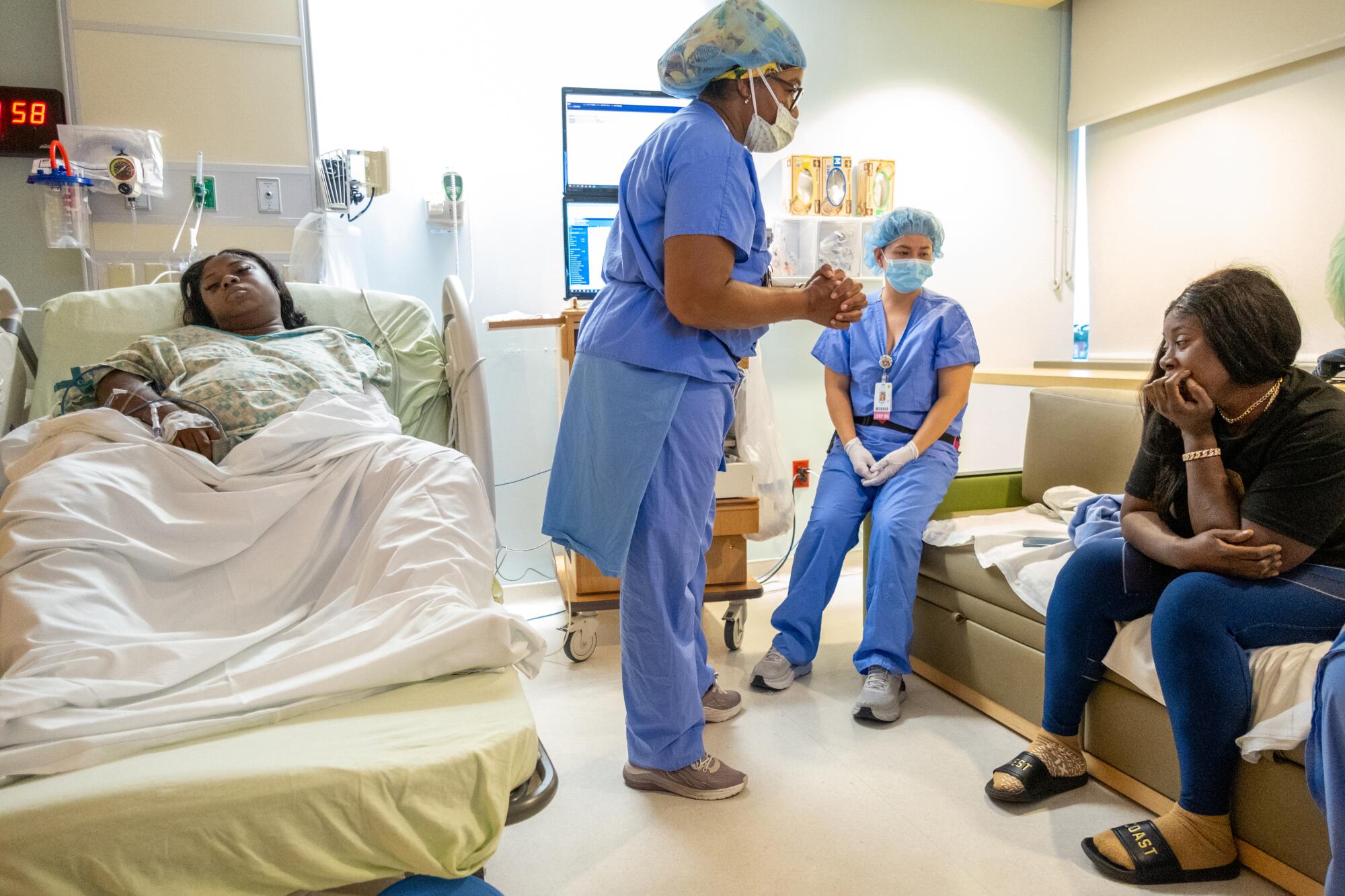
Brianna Mckenzie, 23, left, lies in her bed at MLK Community Hospital. Her mother, Francine Tomlinson, right, had grown anxious, knowing that Mckenzie’s fever could be a sign of an infection. Nurse Monica Waite, middle, speaks with Tomlinson while nurse Rhealou Cadelina observes.
(Francine Orr / Los Angeles Times)
As Mckenzie weighed her options, Angela Sojobi, the midwife who had been tending to the 23-year-old throughout the day, sought to reassure her mother. “We will not let anything bad happen to her,” Sojobi told Tomlinson, sitting down next to her. “That’s why I’m here, watching her like a hawk.”
Mckenzie decided to continue with her labor. Less than five hours later, she was pushing out her newborn son, surrounded by her mother, her partner and the hospital team. Sojobi coached her through each push, her tone steady and soothing: “What a strong woman. Take a breath. You’re almost done.”
At midnight, Mckenzie pushed once more before Sojobi lifted the wailing infant to his mother’s chest.
“He is so gorgeous!” Sojobi exclaimed. “Look at what you did, Brianna!”
It was a euphoric ending that should be unremarkable: A woman safely bringing a baby into the world. But the way MLK Community Hospital is trying to improve the birthing process for its patients remains far from the norm, and hospital officials fear it could be difficult to sustain.

Brianna Mckenzie delivered her son Javen Lucas at MLK Community Hospital at midnight on Aug. 10. “He is so gorgeous!” Midwife Angela Sojobi exclaimed. “Look at what you did, Brianna!” Nurse Lidia Meza, middle, focused on the newborn.
(Francine Orr / Los Angeles Times)
Since it opened its doors eight years ago, the South Los Angeles-area hospital has relied on certified nurse midwives like Sojobi — nurses with graduate-level training in pregnancy and childbirth — working together with obstetricians to manage labors. Midwifery proponents point to evidence that such births are associated with fewer C-sections and preterm births. But as of 2021, only about 10% of hospital births in the U.S. were attended by midwives, according to the National Center for Health Statistics.
At MLK, a certified nurse midwife is routinely at the hospital to guide normal labors, collaborating with an obstetrician who is on site to handle patients who are at high risk or face medical complications during their delivery. Hospital officials said they are trying to give South L.A. patients the best of both worlds: the support of a trained and empathetic nurse midwife and the emergency capabilities of an obstetrician if something goes wrong.

Wayne Morgan cuts the umbilical cord of his son, Javen Lucas. Brianna Mckenzie had just given birth surrounded by certified midwife Angela Sojobi, right corner, and nurses including Lidia Meza, bottom left, and Rhealou Cadelina, middle.
(Francine Orr / Los Angeles Times)
“Most labors start out as a natural process, and a midwife is good at that,” said Dr. Danny Dan, an OB-GYN at MLK. If a birth can proceed without interventions, he said, clinicians can avoid the risk of complications connected to those interventions, which must be weighed against their possible benefits.
“The problem is, when labor turns bad, it turns bad very quickly,” Dan said. In general, “you really don’t need a doctor — until you need a doctor.”
Holly Smith, health policy chair of the California Nurse-Midwives Assn, said that in California, having both midwives and obstetricians working full time has typically been more common at bigger entities such as Kaiser Permanente than at a smaller hospital like MLK, especially one serving a disadvantaged community. MLK officials credit round-the-clock staffing with an OB and midwife with driving its notably low rates of C-sections and episiotomies, measures widely used to gauge the quality of maternal care.
Roughly 14% of its first-time, low-risk births involved a C-section, compared with about 23% of such births statewide, according to statistics gathered by Cal Hospital Compare. Hospital data provided by Sojobi also indicate that most newborns at MLK are in good condition shortly after birth, based on a common metric used to assess newborns.
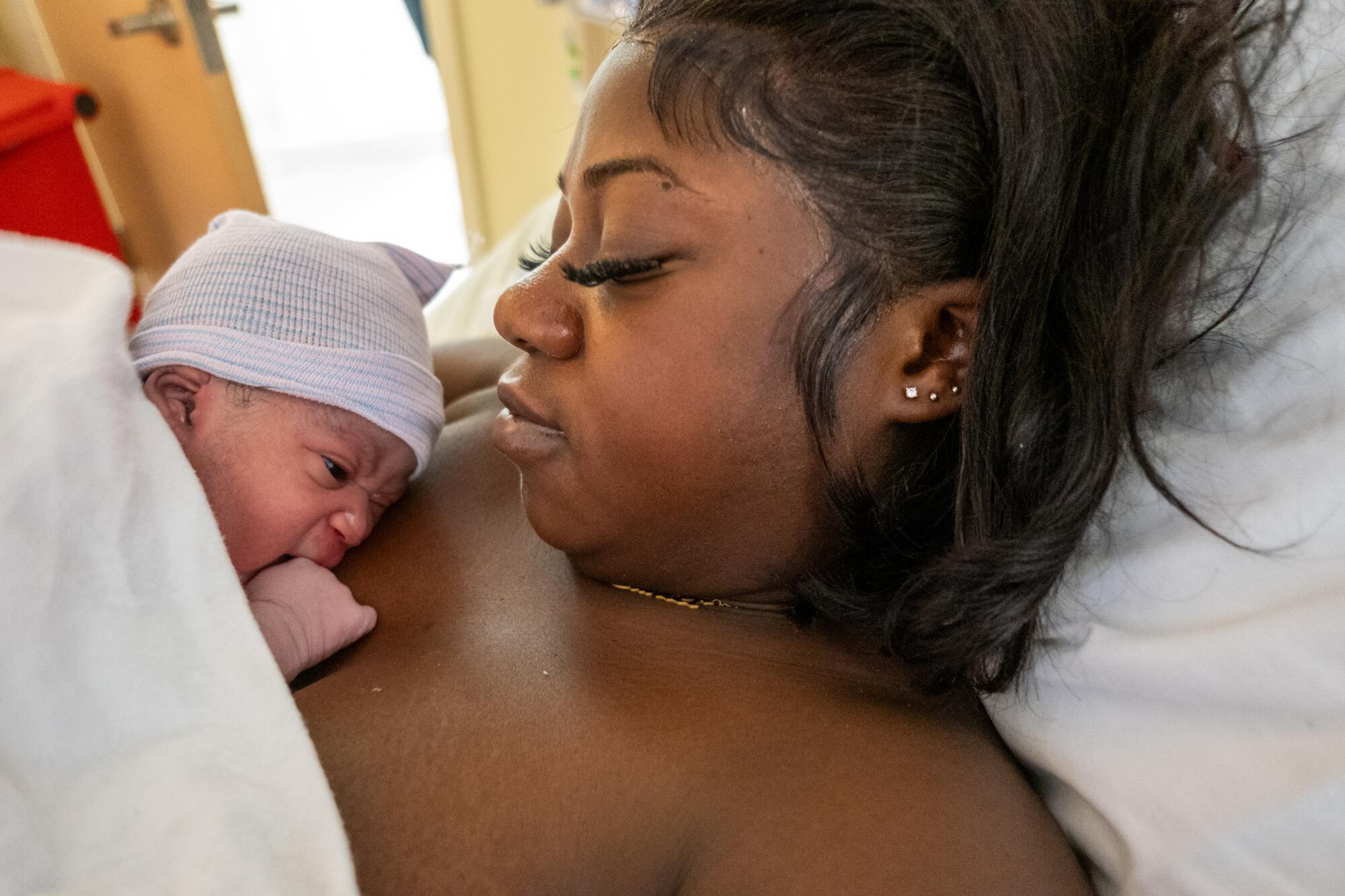
New mother Brianna Mckenzie holds her newborn baby boy.
(Francine Orr / Los Angeles Times)
“We allow the body to do what it does best,” Sojobi said. Medical staff will not hesitate to intervene when needed, she added, but “when we intervene unnecessarily in a normal process, that’s when we end up with problems.”
Midwifery has also been promoted as a way to provide more sensitive and individualized care, an especially urgent concern for Black women. Thirty percent of Black women reported mistreatment during maternity care and 40% reported discrimination, according to a Centers for Disease Control and Prevention analysis of a national survey — rates markedly higher than among white women surveyed.
Listening to women and taking their pain seriously “sounds so basic, but it can literally save people’s lives,” said Jessica Wade, a maternal and infant health manager with the March of Dimes in California.

Nurse Edna Picardal, left, swaddles newborn Javen Lucas. New mother Brianna Mckenzie, right, speaks with nurse midwife Teresa Jarvis.
(Francine Orr / Los Angeles Times)
In California, Black mothers have been the most likely to express interest in having a midwife in the future — and the least likely to have worked with one, according to a Commonwealth Fund analysis. Midwives are far more common in many other wealthy countries than the U.S., where midwifery was historically marginalized as birth care shifted to hospitals. One famed obstetrician denounced midwives in 1915 as “a drag on the progress of the science and art of obstetrics.”
Midwifery has regained some ground since then, but many patients remain unable to access such care due to insurance barriers, regulatory restrictions, or a shortage of providers. Cultural acceptance of the role of midwifery is “inconsistent,” said Kim Q. Dau, co-specialty coordinator of the nurse midwifery education program at UC San Francisco School of Nursing, and “it is really hard to keep up with workforce demands” with only two programs educating nurse midwives across the state.
Dr. Neel Shah, a Harvard Medical School visiting scientist focused on maternal health, argued that everyone who is giving birth can benefit from support, monitoring and coaching. Some patients also benefit from medical technology like epidurals, and a minority benefit from surgeons, “which is what obstetricians are.”
In the U.S., “it’s the opposite,” he said, “Everyone gets the surgeon … and the thing we’ve forgotten about is the support.”
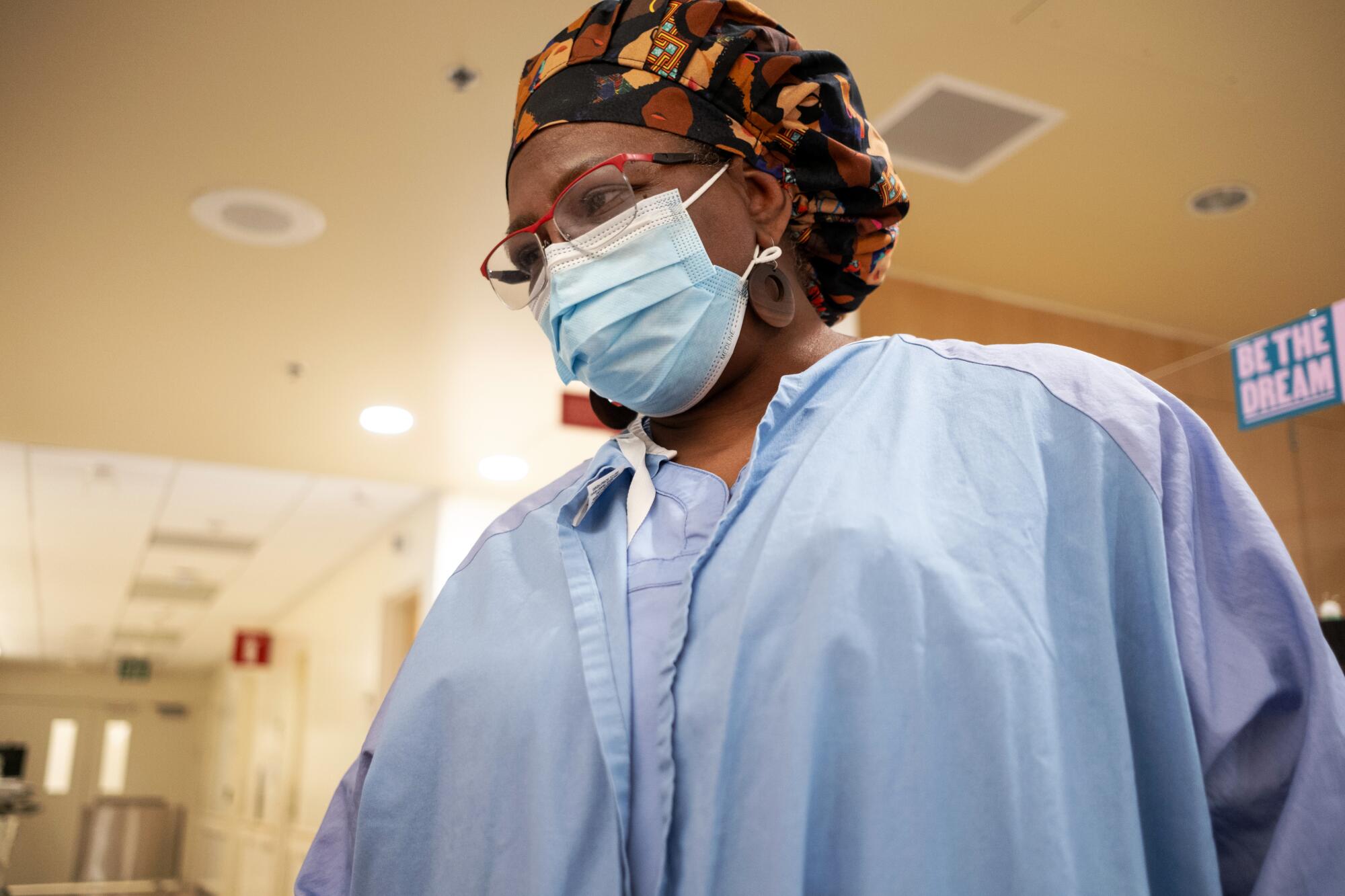
Nurse Midwife Angela Sojobi said that what stands out to her is the fear among her patients, who are mostly Latina and Black. “Women looking at me and saying, ‘Please don’t let anything happen to me.’ ”
(Francine Orr / Los Angeles Times)
Sojobi has worked as a midwife in the U.S. and Nigeria, where she was born. There, she said, having a midwife was routine for a normal labor, and for many pregnant patients, “the prayer would be, ‘Dear God, don’t let me see a physician.’ Because when you see the physician, that means something is wrong.”
When Sojobi came to the U.S. as a nurse decades ago, she said, midwives were so uncommon in its hospitals that she did not realize they existed here at all. As a nurse attending births in the 1980s, Sojobi said, she cringed when she observed patients being hustled to the operating room if they hadn’t given birth by a set time.
When she was a patient in labor in the U.S., she said, she was frustrated when a clinician gave her a pain medication she didn’t want without any warning, leaving her dizzy and alarmed. “Her heart was in a good place,” Sojobi said, but she was upset to not be asked what she wanted or even informed what was happening.
At her next birth in the U.S., Sojobi said, her doctor wanted her to undergo a C-section because her labor had been progressing slowly. But Sojobi and her baby were faring well. She told her doctor that she was OK with waiting and asked her to come back in four hours. “By the time she came back, I was ready to push.”
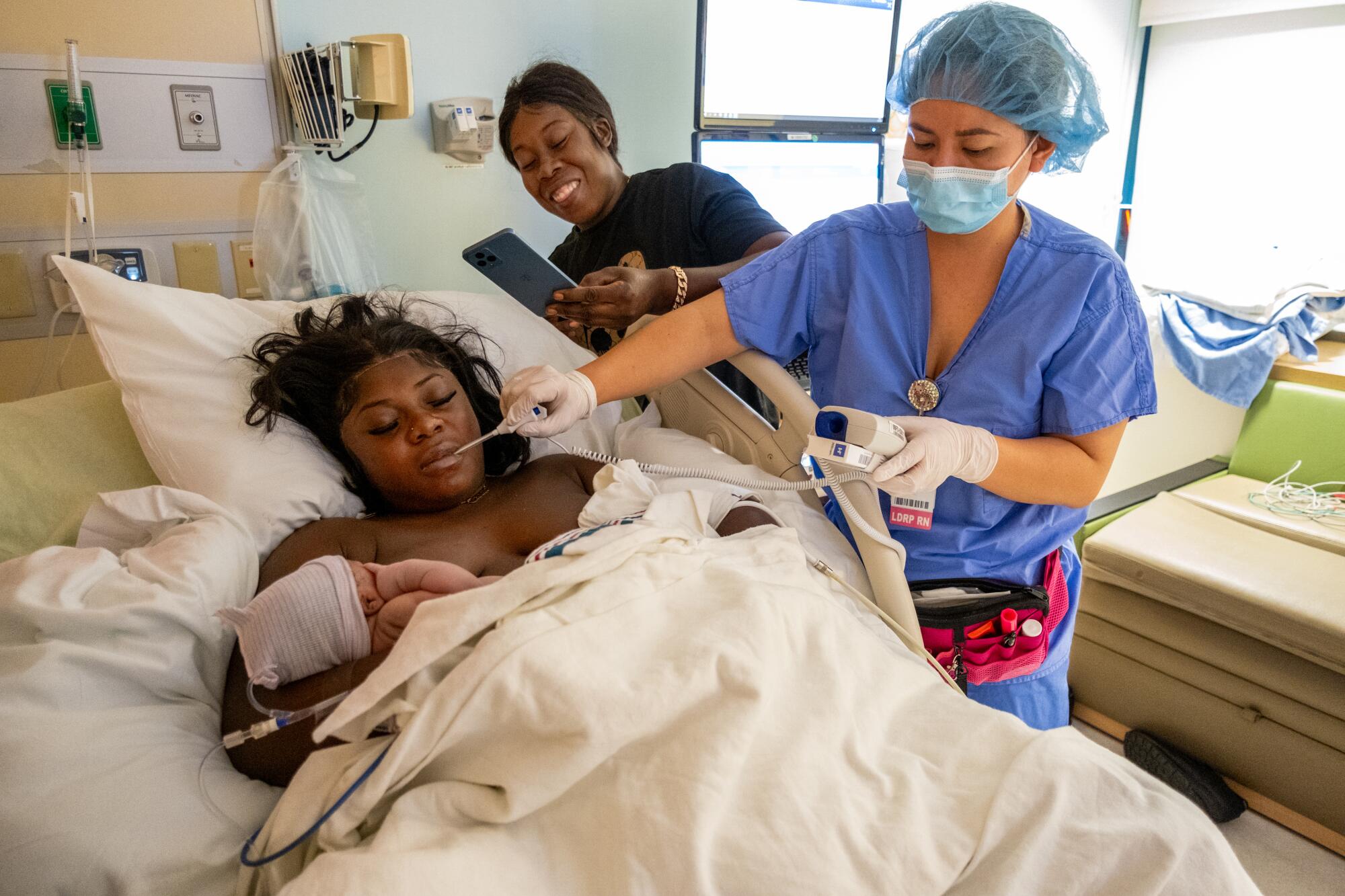
Francine Tomlinson snaps photos of her newborn grandson Javen Lucas resting in the arms of his mother, Brianna Mckenzie.
(Francine Orr / Los Angeles Times)
Cesarean sections can save lives, but global studies suggest they have become much more common than is necessary. In the U.S., they account for one-third of births rather than the 15% to 19% researchers have found to be optimal in developed countries. Maternal mortality in the U.S. has been going up rather than down in recent decades, researchers have found — and only worsened amid the pandemic, according to national statistics.
Dan, the obstetrician, said what MLK is doing is allowing the normal process of birth to play out with time, with the medical tools and expertise of physicians at hand if anything veers away from what is normal. As Sojobi kept monitoring and checking on Mckenzie progressing in her labor, Pinches was on site at the hospital and ready to step in if needed. Sojobi pointed out to a reporter that the operating room was nearby, through a set of swinging doors down the hall.
It’s a system that closely matches what South L.A. women told researchers they wanted, when MLK commissioned focus groups in the area. Most said they felt safer giving birth in a hospital, with ready access to technology and medication, but also wanted the care of a midwife or birth doula, the research group found.
“To me this is as perfect as it gets,” Dan said one afternoon, gesturing around the labor and delivery unit.
“But it’s very costly to have this model.”

Brianna Mckenzie and her newborn son in the labor and delivery unit at MLK Community Hospital.
(Francine Orr / Los Angeles Times)
Employing midwives around the clock at MLK costs more than $700,000 annually, in addition to the costs of staffing the unit with other clinicians. The hospital has been under financial strain for years as it tries to survive on reimbursements under Medicaid, which covers the bulk of its patients and pays less than commercial insurers. California recently granted it a $14-million no-interest loan under a program for hospitals in financial distress; MLK officials said they were grateful for the loan, but that it would not plug its annual losses.
Dr. Elaine Batchlor, chief executive of MLK Community Healthcare, estimated that the hospital loses more than $2 million annually on its labor and delivery unit. Across the country, many hospitals have been cutting labor and delivery units entirely in the face of financial pressures. In California, the number of hospitals with birthing services fell by a fifth between 2019 and 2020, according to a March of Dimes analysis — and more have closed their maternity units in the years since.
Labor and delivery units need a lot of staff, which means they typically lose money unless a hospital is delivering thousands of babies annually, Shah said. In areas where more patients rely on Medicaid than commercial insurance, the financial strain is worse. And industry groups say labor costs have risen as hospitals continue to grapple with short staffing after the eruption of the pandemic.
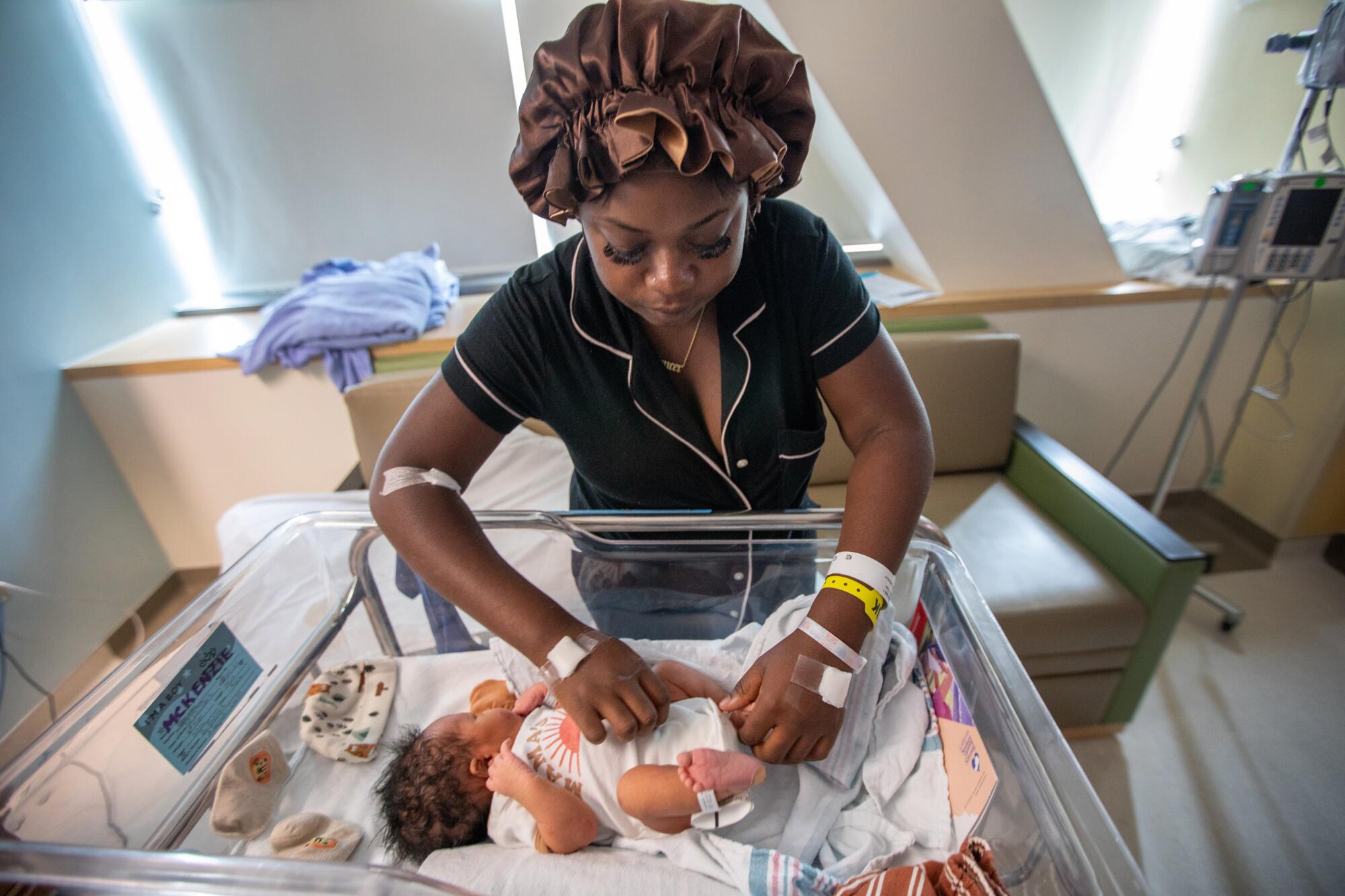
Brianna Mckenzie dresses her son Javen Lucas Morgan in the hospital.
(Francine Orr / Los Angeles Times)
Such closures have hit rural areas especially hard, creating “maternity care deserts” in more than a third of U.S. counties, the March of Dimes found. But urban and suburban areas have also lost birthing units, including in Los Angeles County. In the South Bay, Memorial Hospital of Gardena closed its maternity services three years ago. East of Los Angeles in Montebello, Beverly Hospital announced this spring that it would be halting maternity services and filed for bankruptcy protection.
And in Inglewood, Centinela Hospital Medical Center is closing its unit in October, citing declining births. The decision was announced before the hospital was dealt a $75,000 state fine for faulty practices that led to the death of a woman admitted to its labor and delivery unit.

Javen Lucas Morgan was born at midnight on Aug. 10 in the labor and delivery unit at MLK Community Hospital.
(Francine Orr / Los Angeles Times)
The state did not name the patient, but the date and details of the death matched those of April Valentine, a 31-year-old Black woman who died at Centinela in January. Another mother, a Black woman named Bridgette Burks, died in March at California Hospital Medical Center in the aftermath of a C-section, leaving behind five children and a devastated husband. Again, the state did not name the patient, but investigators found the hospital failed to address signs of a hemorrhage before a birthing patient died that day.
And in July, a federal agency confirmed Cedars-Sinai Medical Center is facing a federal civil rights investigation over how it treats Black women who give birth there, years after the death of Kira Dixon Johnson, whose husband told Congress that he was “smitten with her zest for life.”
Black women in the U.S. were more than 2½ times as likely to die in pregnancy and its aftermath than white women in 2021, national data show. Such disparities exist even for wealthy Black mothers, who are about as likely to die of pregnancy-related causes as the poorest white mothers, according to an analysis of California deaths published in the National Bureau of Economic Research. And Black babies are also at a higher risk of death than white infants.
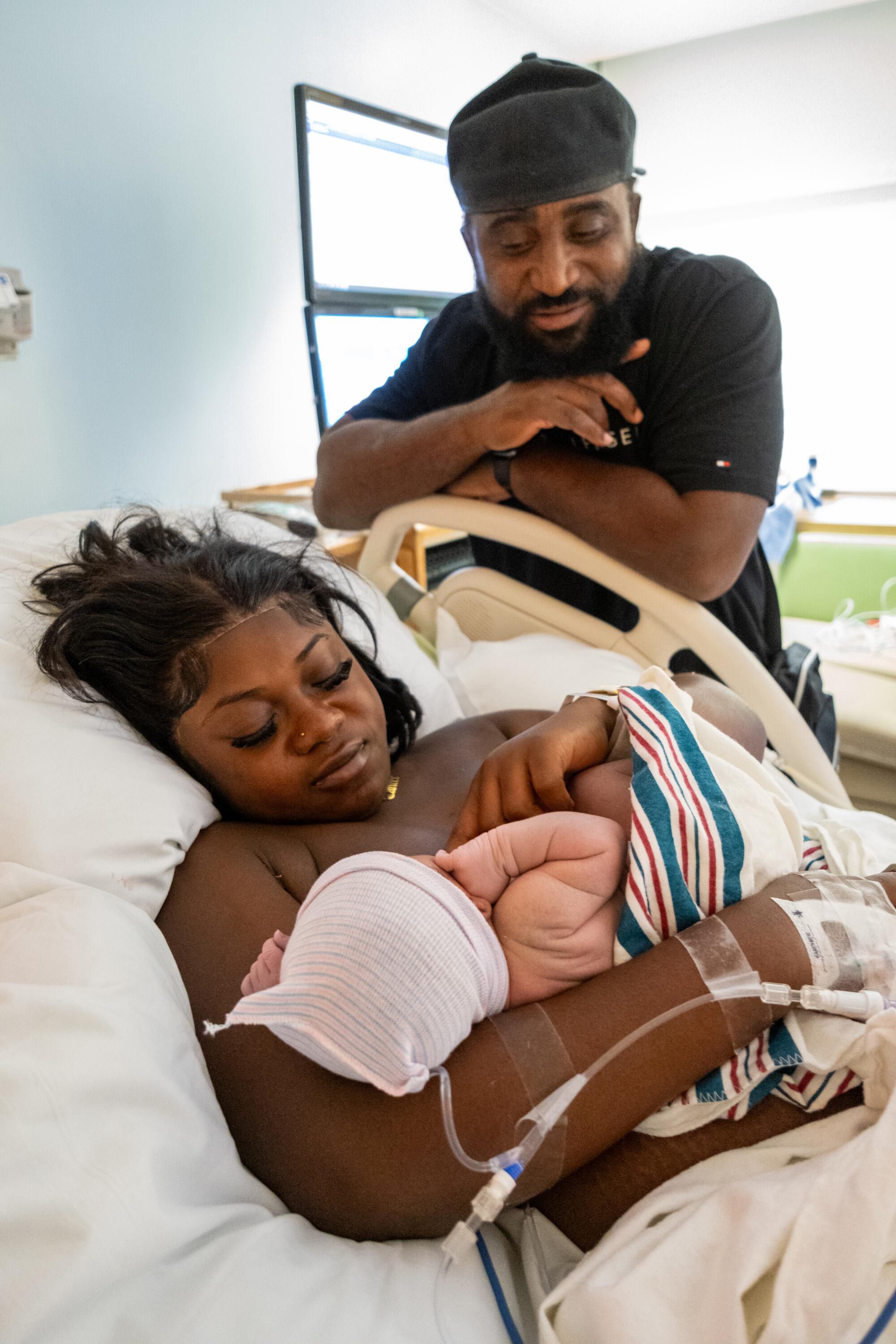
Brianna Mckenzie holds Javen Lucas Morgan as her partner, Wayne Morgan, proudly looks on. When she was trying to figure out where she wanted to deliver her baby, she toured several hospitals before deciding on MLK, noting its low rates of cesarean sections.
(Francine Orr / Los Angeles Times)
Sojobi said in the South L.A. area, what stands out to her is the fear among her patients, who are mostly Latina and Black. “Women looking at me and saying, ‘Please don’t let anything happen to me.’” At MLK, “from the second the patient walks in the door, they’re shown respect. They’re listened to.”
“We don’t just dictate what’s going to happen to them,” she said.
A United Nations analysis found that Black women are “disadvantaged before, during and after pregnancy” and faulted structural racism and sexism for alarming levels of Black maternal mortality across the Americas. Researchers have increasingly focused on the toll of racism within the healthcare system and the kind of care that Black women receive before, during and after childbirth, as well as the physical effects of chronic stress endured by Black women in the U.S.
Racism “is so deeply embedded in the system that it is not surprising that we have these outcomes,” said Janette Robinson Flint, executive director of Black Women for Wellness, an organization that engages in education and advocacy for the health of Black women and girls. “What is surprising is that we continue to tolerate it.”
The bulk of pregnancy-related deaths in the U.S. are preventable, researchers have found. Across California, more than two dozen people have died since January of complications of pregnancy, childbirth or its aftermath, according to state data from death certificates. California has had lower rates of such deaths than other states, but “I don’t think California can rest on its laurels,” Robinson Flint said. “Why would we accept that it’s OK that women have died giving birth this year?”
When Mckenzie moved to Los Angeles and began looking for a hospital to deliver her baby, she knew she wanted a facility that wouldn’t put her in the position of having to choose between herself and the baby, she said. She toured several hospitals before deciding on MLK, noting its low rates of cesarean sections.
“I wanted a safe delivery. I wanted staff members who listened to me. … And that’s what they were about.” She was reassured that Sojobi was checking on her constantly, and praised another nurse, Monica Waite, as being “like a mom.”
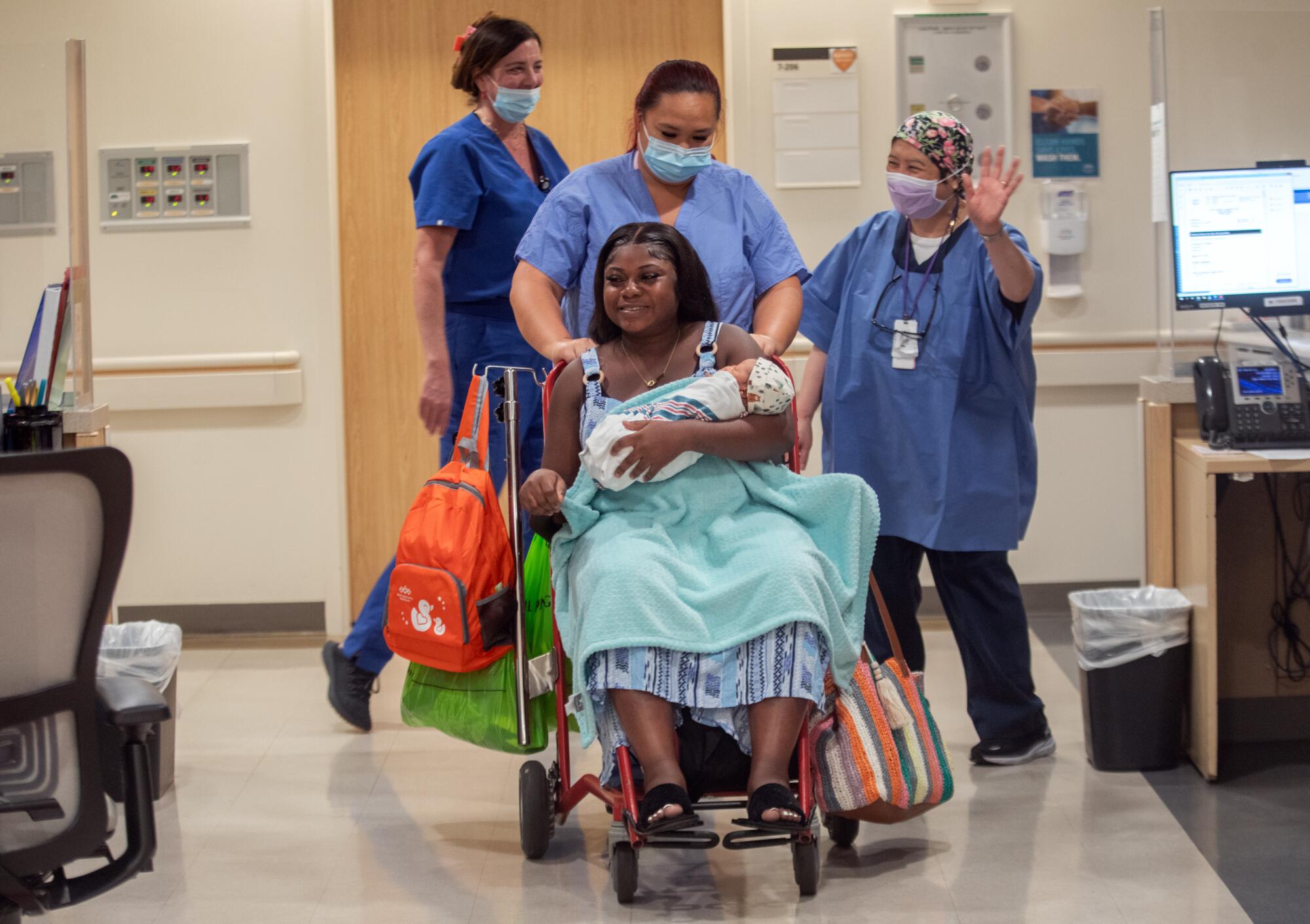
Brianna Mckenzie left the hospital on Aug. 10. Nurse Clare Francisco wheels her out as nurse Edna Picardal, right, waves goodbye.
(Francine Orr / Los Angeles Times)
“They really treated me like I belonged,” Mckenzie said. “For Black women, it’s rare to find that.”
Before her son was born, Mckenzie told nurses that she hadn’t picked a name. But shortly after her partner Wayne Morgan cut the umbilical cord, the name sprang readily to her lips: Javen Lucas. Javen, for her brother who had gone missing in Jamaica, where her family is from. Lucas, which means “bringer of light.”
She had long since chosen the name, but wanted to surprise her mother. Her family had lost a boy, “and then God blessed me with another boy,” McKenzie said. “The entire family was in a place of darkness due to my brother being missing.”
“And I do feel like his name — and him — kind of brightened up everything.”
It was just after midnight at MLK Community Hospital. Morgan was leaning over Mckenzie, speaking softly to his son. Tomlinson gazed at the sight of her first grandchild cradled in the arms of her daughter. Sojobi kidded with the new grandmother that she had grown new gray hairs.
“You have done a good job,” Tomlinson told Sojobi with relief.
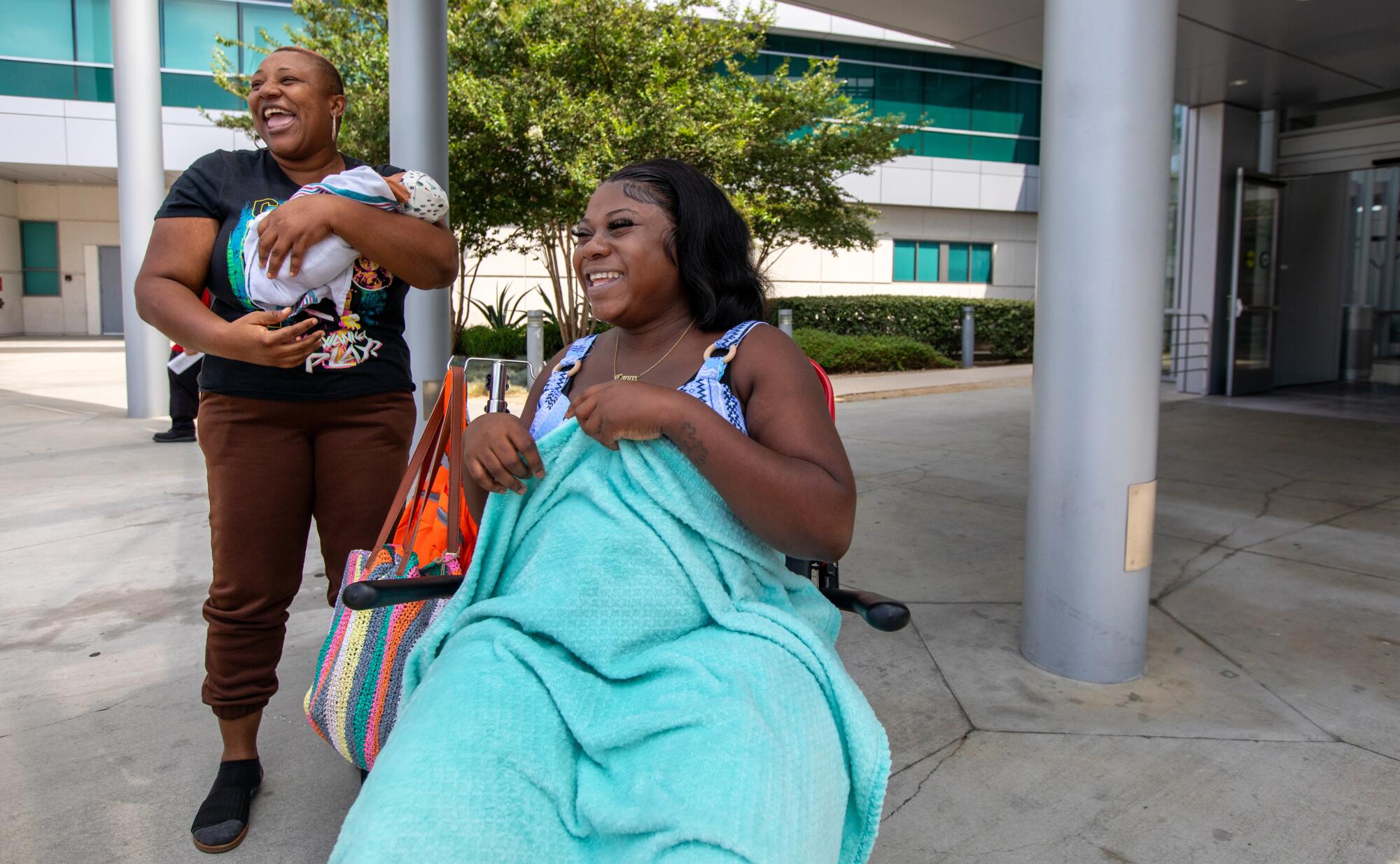
Family members, including Javen’s aunt Natalie, came to pick up Brianna Mckenzie and her newborn son.
(Francine Orr / Los Angeles Times)
Sojobi later reflected that in other circumstances, Mckenzie might have quickly undergone a C-section after her mother grew concerned. Fear of litigation can weigh on those decisions by doctors, researchers have found. But Sojobi said what made the difference at MLK was time: Time to talk with Tomlinson about her fears and reassure her. Time to shift Mckenzie into different positions to help the baby turn and descend, even with the constraints of an epidural.
“This is what we live for,” Sojobi said, beaming over the red frames of her eyeglasses.

Science
Cluster of farmworkers diagnosed with rare animal-borne disease in Ventura County

A cluster of workers at Ventura County berry farms have been diagnosed with a rare disease often transmitted through sick animals’ urine, according to a public health advisory distributed to local doctors by county health officials Tuesday.
The bacterial infection, leptospirosis, has resulted in severe symptoms for some workers, including meningitis, an inflammation of the brain lining and spinal cord. Symptoms for mild cases included headaches and fevers.
The disease, which can be fatal, rarely spreads from human to human, according to the U.S. Centers for Disease Control and Prevention.
Ventura County Public Health has not given an official case count but said it had not identified any cases outside of the agriculture sector. The county’s agriculture commissioner was aware of 18 cases, the Ventura County Star reported.
The health department said it was first contacted by a local physician in October, who reported an unusual trend in symptoms among hospital patients.
After launching an investigation, the department identified leptospirosis as a probable cause of the illness and found most patients worked on caneberry farms that utilize hoop houses — greenhouse structures to shelter the crops.
As the investigation to identify any additional cases and the exact sources of exposure continues, Ventura County Public Health has asked healthcare providers to consider a leptospirosis diagnosis for sick agricultural workers, particularly berry harvesters.
Rodents are a common source and transmitter of disease, though other mammals — including livestock, cats and dogs — can transmit it as well.
The disease is spread through bodily fluids, such as urine, and is often contracted through cuts and abrasions that contact contaminated water and soil, where the bacteria can survive for months.
Humans can also contract the illness through contaminated food; however, the county health agency has found no known health risks to the general public, including through the contact or consumption of caneberries such as raspberries and blackberries.
Symptom onset typically occurs between two and 30 days after exposure, and symptoms can last for months if untreated, according to the CDC.
The illness often begins with mild symptoms, with fevers, chills, vomiting and headaches. Some cases can then enter a second, more severe phase that can result in kidney or liver failure.
Ventura County Public Health recommends agriculture and berry harvesters regularly rinse any cuts with soap and water and cover them with bandages. They also recommend wearing waterproof clothing and protection while working outdoors, including gloves and long-sleeve shirts and pants.
While there is no evidence of spread to the larger community, according to the department, residents should wash hands frequently and work to control rodents around their property if possible.
Pet owners can consult a veterinarian about leptospirosis vaccinations and should keep pets away from ponds, lakes and other natural bodies of water.
Science
Political stress: Can you stay engaged without sacrificing your mental health?

It’s been two weeks since Donald Trump won the presidential election, but Stacey Lamirand’s brain hasn’t stopped churning.
“I still think about the election all the time,” said the 60-year-old Bay Area resident, who wanted a Kamala Harris victory so badly that she flew to Pennsylvania and knocked on voters’ doors in the final days of the campaign. “I honestly don’t know what to do about that.”
Neither do the psychologists and political scientists who have been tracking the country’s slide toward toxic levels of partisanship.
Fully 69% of U.S. adults found the presidential election a significant source of stress in their lives, the American Psychological Assn. said in its latest Stress in America report.
The distress was present across the political spectrum, with 80% of Republicans, 79% of Democrats and 73% of independents surveyed saying they were stressed about the country’s future.
That’s unhealthy for the body politic — and for voters themselves. Stress can cause muscle tension, headaches, sleep problems and loss of appetite. Chronic stress can inflict more serious damage to the immune system and make people more vulnerable to heart attacks, strokes, diabetes, infertility, clinical anxiety, depression and other ailments.
In most circumstances, the sound medical advice is to disengage from the source of stress, therapists said. But when stress is coming from politics, that prescription pits the health of the individual against the health of the nation.
“I’m worried about people totally withdrawing from politics because it’s unpleasant,” said Aaron Weinschenk, a political scientist at the University of Wisconsin–Green Bay who studies political behavior and elections. “We don’t want them to do that. But we also don’t want them to feel sick.”
Modern life is full of stressors of all kinds: paying bills, pleasing difficult bosses, getting along with frenemies, caring for children or aging parents (or both).
The stress that stems from politics isn’t fundamentally different from other kinds of stress. What’s unique about it is the way it encompasses and enhances other sources of stress, said Brett Ford, a social psychologist at the University of Toronto who studies the link between emotions and political engagement.
For instance, she said, elections have the potential to make everyday stressors like money and health concerns more difficult to manage as candidates debate policies that could raise the price of gas or cut off access to certain kinds of medical care.
Layered on top of that is the fact that political disagreements have morphed into moral conflicts that are perceived as pitting good against evil.
“When someone comes into power who is not on the same page as you morally, that can hit very deeply,” Ford said.
Partisanship and polarization have raised the stakes as well. Voters who feel a strong connection to a political party become more invested in its success. That can make a loss at the ballot box feel like a personal defeat, she said.
There’s also the fact that we have limited control over the outcome of an election. A patient with heart disease can improve their prognosis by taking medicine, changing their diet, getting more exercise or quitting smoking. But a person with political stress is largely at the mercy of others.
“Politics is many forms of stress all rolled into one,” Ford said.
Weinschenk observed this firsthand the day after the election.
“I could feel it when I went into my classroom,” said the professor, whose research has found that people with political anxiety aren’t necessarily anxious in general. “I have a student who’s transgender and a couple of students who are gay. Their emotional state was so closed down.”
That’s almost to be expected in a place like Wisconsin, whose swing-state status caused residents to be bombarded with political messages. The more campaign ads a person is exposed to, the greater the risk of being diagnosed with anxiety, depression or another psychological ailment, according to a 2022 study in the journal PLOS One.
Political messages seem designed to keep voters “emotionally on edge,” said Vaile Wright, a licensed psychologist in Villa Park, Ill., and a member of the APA’s Stress in America team.
“It encourages emotion to drive our decision-making behavior, as opposed to logic,” Wright said. “When we’re really emotionally stimulated, it makes it so much more challenging to have civil conversation. For politicians, I think that’s powerful, because emotions can be very easily manipulated.”
Making voters feel anxious is a tried-and-true way to grab their attention, said Christopher Ojeda, a political scientist at UC Merced who studies mental health and politics.
“Feelings of anxiety can be mobilizing, definitely,” he said. “That’s why politicians make fear appeals — they want people to get engaged.”
On the other hand, “feelings of depression are demobilizing and take you out of the political system,” said Ojeda, author of “The Sad Citizen: How Politics is Depressing and Why it Matters.”
“What [these feelings] can tell you is, ‘Things aren’t going the way I want them to. Maybe I need to step back,’” he said.
Genessa Krasnow has been seeing a lot of that since the election.
The Seattle entrepreneur, who also campaigned for Harris, said it grates on her to see people laughing in restaurants “as if nothing had happened.” At a recent book club meeting, her fellow group members were willing to let her vent about politics for five minutes, but they weren’t interested in discussing ways they could counteract the incoming president.
“They’re in a state of disengagement,” said Krasnow, who is 56. She, meanwhile, is looking for new ways to reach young voters.
“I am exhausted. I am so sad,” she said. “But I don’t believe that disengaging is the answer.”
That’s the fundamental trade-off, Ojeda said, and there’s no one-size-fits-all solution.
“Everyone has to make a decision about how much engagement they can tolerate without undermining their psychological well-being,” he said.
Lamirand took steps to protect her mental health by cutting social media ties with people whose values aren’t aligned with hers. But she will remain politically active and expects to volunteer for phone-banking duty soon.
“Doing something is the only thing that allows me to feel better,” Lamirand said. “It allows me to feel some level of control.”
Ideally, Ford said, people would not have to choose between being politically active and preserving their mental health. She is investigating ways to help people feel hopeful, inspired and compassionate about political challenges, since these emotions can motivate action without triggering stress and anxiety.
“We want to counteract this pattern where the more involved you are, the worse you are,” Ford said.
The benefits would be felt across the political spectrum. In the APA survey, similar shares of Democrats, Republicans and independents agreed with statements like, “It causes me stress that politicians aren’t talking about the things that are most important to me,” and, “The political climate has caused strain between my family members and me.”
“Both sides are very invested in this country, and that is a good thing,” Wright said. “Antipathy and hopelessness really doesn’t serve us in the long run.”
Science
Video: SpaceX Unable to Recover Booster Stage During Sixth Test Flight

President-elect Donald Trump joined Elon Musk in Texas and watched the launch from a nearby location on Tuesday. While the Starship’s giant booster stage was unable to repeat a “chopsticks” landing, the vehicle’s upper stage successfully splashed down in the Indian Ocean.
-

 Business1 week ago
Business1 week agoColumn: Molly White's message for journalists going freelance — be ready for the pitfalls
-

 Science6 days ago
Science6 days agoTrump nominates Dr. Oz to head Medicare and Medicaid and help take on 'illness industrial complex'
-

 Politics1 week ago
Politics1 week agoTrump taps FCC member Brendan Carr to lead agency: 'Warrior for Free Speech'
-
/cdn.vox-cdn.com/uploads/chorus_asset/file/25739950/247386_Elon_Musk_Open_AI_CVirginia.jpg)
/cdn.vox-cdn.com/uploads/chorus_asset/file/25739950/247386_Elon_Musk_Open_AI_CVirginia.jpg) Technology1 week ago
Technology1 week agoInside Elon Musk’s messy breakup with OpenAI
-

 Lifestyle1 week ago
Lifestyle1 week agoSome in the U.S. farm industry are alarmed by Trump's embrace of RFK Jr. and tariffs
-

 World1 week ago
World1 week agoProtesters in Slovakia rally against Robert Fico’s populist government
-

 Health2 days ago
Health2 days agoHoliday gatherings can lead to stress eating: Try these 5 tips to control it
-

 News1 week ago
News1 week agoThey disagree about a lot, but these singers figure out how to stay in harmony


/cdn.vox-cdn.com/uploads/chorus_asset/file/25286459/247024_Pilot_Pen_CVirginia.jpg)











